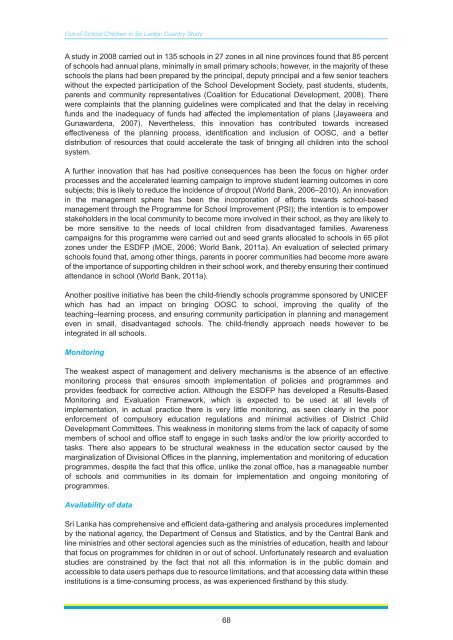Sri Lanka - Institut de statistique de l'Unesco
Sri Lanka - Institut de statistique de l'Unesco
Sri Lanka - Institut de statistique de l'Unesco
You also want an ePaper? Increase the reach of your titles
YUMPU automatically turns print PDFs into web optimized ePapers that Google loves.
Out-of-School Children in <strong>Sri</strong> <strong>Lanka</strong>: Country Study<br />
A study in 2008 carried out in 135 schools in 27 zones in all nine provinces found that 85 percent<br />
of schools had annual plans, minimally in small primary schools; however, in the majority of these<br />
schools the plans had been prepared by the principal, <strong>de</strong>puty principal and a few senior teachers<br />
without the expected participation of the School Development Society, past stu<strong>de</strong>nts, stu<strong>de</strong>nts,<br />
parents and community representatives (Coalition for Educational Development, 2008). There<br />
were complaints that the planning gui<strong>de</strong>lines were complicated and that the <strong>de</strong>lay in receiving<br />
funds and the ina<strong>de</strong>quacy of funds had affected the implementation of plans (Jayaweera and<br />
Gunawar<strong>de</strong>na, 2007). Nevertheless, this innovation has contributed towards increased<br />
effectiveness of the planning process, i<strong>de</strong>ntification and inclusion of OOSC, and a better<br />
distribution of resources that could accelerate the task of bringing all children into the school<br />
system.<br />
A further innovation that has had positive consequences has been the focus on higher or<strong>de</strong>r<br />
processes and the accelerated learning campaign to improve stu<strong>de</strong>nt learning outcomes in core<br />
subjects; this is likely to reduce the inci<strong>de</strong>nce of dropout (World Bank, 2006–2010). An innovation<br />
in the management sphere has been the incorporation of efforts towards school-based<br />
management through the Programme for School Improvement (PSI); the intention is to empower<br />
stakehol<strong>de</strong>rs in the local community to become more involved in their school, as they are likely to<br />
be more sensitive to the needs of local children from disadvantaged families. Awareness<br />
campaigns for this programme were carried out and seed grants allocated to schools in 65 pilot<br />
zones un<strong>de</strong>r the ESDFP (MOE, 2006; World Bank, 2011a). An evaluation of selected primary<br />
schools found that, among other things, parents in poorer communities had become more aware<br />
of the importance of supporting children in their school work, and thereby ensuring their continued<br />
attendance in school (World Bank, 2011a).<br />
Another positive initiative has been the child-friendly schools programme sponsored by UNICEF<br />
which has had an impact on bringing OOSC to school, improving the quality of the<br />
teaching–learning process, and ensuring community participation in planning and management<br />
even in small, disadvantaged schools. The child-friendly approach needs however to be<br />
integrated in all schools.<br />
Monitoring<br />
The weakest aspect of management and <strong>de</strong>livery mechanisms is the absence of an effective<br />
monitoring process that ensures smooth implementation of policies and programmes and<br />
provi<strong>de</strong>s feedback for corrective action. Although the ESDFP has <strong>de</strong>veloped a Results-Based<br />
Monitoring and Evaluation Framework, which is expected to be used at all levels of<br />
implementation, in actual practice there is very little monitoring, as seen clearly in the poor<br />
enforcement of compulsory education regulations and minimal activities of District Child<br />
Development Committees. This weakness in monitoring stems from the lack of capacity of some<br />
members of school and office staff to engage in such tasks and/or the low priority accor<strong>de</strong>d to<br />
tasks. There also appears to be structural weakness in the education sector caused by the<br />
marginalization of Divisional Offices in the planning, implementation and monitoring of education<br />
programmes, <strong>de</strong>spite the fact that this office, unlike the zonal office, has a manageable number<br />
of schools and communities in its domain for implementation and ongoing monitoring of<br />
programmes.<br />
Availability of data<br />
<strong>Sri</strong> <strong>Lanka</strong> has comprehensive and efficient data-gathering and analysis procedures implemented<br />
by the national agency, the Department of Census and Statistics, and by the Central Bank and<br />
line ministries and other sectoral agencies such as the ministries of education, health and labour<br />
that focus on programmes for children in or out of school. Unfortunately research and evaluation<br />
studies are constrained by the fact that not all this information is in the public domain and<br />
accessible to data users perhaps due to resource limitations, and that accessing data within these<br />
institutions is a time-consuming process, as was experienced firsthand by this study.<br />
68

















